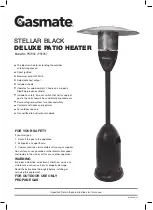
16
discharge opening must not be blocked or reduced in size under any
circumstances. Excessive length, over 30 feet (9.14 m), or use of
more than four elbows can cause restriction and reduce the discharge
capacity of the valve.
No valve or other obstruction is to be placed between the
Temperature-Pressure Relief Valve and the tank. Do not connect
discharge piping directly to the drain unless a 6” (15.2 cm) air gap is
provided. To prevent bodily injury, hazard to life, or property damage,
the relief valve must be allowed to discharge water in adequate
quantities should circumstances demand. If the discharge pipe is
not connected to a drain or other suitable means, the water flow
may cause property damage.
CAUTION
•
Temperature-Pressure Relief Valve discharge
pipe must terminate at adequate drain.
Wa
ter Damage Hazard
t&p valve discharge pipe requirements:
• Should not be smaller in size than the outlet pipe size of the valve, or
have any reducing couplings or other restrictions.
• Should not be plugged or blocked.
• Should not be exposed to freezing temperatures.
• Should be of material listed for hot water distribution.
• Should be installed so as to allow complete drainage of both the
Temperature-Pressure Relief Valve and the discharge pipe.
• Must terminate a maximum of six inches above a floor drain or external
to the building. In cold climates, it is recommended that the discharge
pipe be terminated at an adequate drain inside the building.
• Should not have any valve or other obstruction between the relief
valve and the drain.
DANGER
•
Burn hazard.
•
Hot water discharge.
•
Keep clear of Temperature-
Pressure Relief Valve
discharge outlet.
The Temperature-Pressure Relief Valve must be manually operated at
least twice a year. Caution should be taken to ensure that (1) no one
is in front of or around the outlet of the Temperature-Pressure Relief
Valve discharge line, and (2) the water manually discharged will not
cause any bodily injury or property damage because the water may be
extremely hot. If after manually operating the valve, it fails to completely
reset and continues to release water, immediately close the cold water
inlet to the water heater, follow the draining instructions in this manual,
and replace the Temperature-Pressure Relief Valve with a properly
rated/sized new one.
note:
The purpose of a Temperature-Pressure Relief Valve is to
prevent excessive temperatures and pressures in the storage tank.
The T&P valve is not intended for the constant relief of thermal
expansion. A properly sized thermal expansion tank must be installed
on all closed systems to control thermal expansion, see Closed Water
Systems and Thermal Expansion on page 14 and 15.
If you do not understand these instructions or have any questions
regarding the Temperature-Pressure Relief Valve call the
toll free number listed on the back cover of this manual for
technical assistance.
hIGh altItude InstallatIon
This heater is approved for operation up to 5,300 feet (1,615 m)
without alteration. High altitude models are available from the factory
for elevations between 5,300 feet (1,615 m) and 10,100 feet (3,079
m). For elevations above 10,100 feet (3,079 m) the input rating
should be reduced at the rate of 4 percent for each 1,000 feet (305
m) above sea level which requires replacement of the burner orifice
in accordance with National Fuel Gas Code (ANSI Z223.1/NFPA 54).
Contact your local gas supplier for further information.
Failure to replace standard orifice with a high altitude orifice when
installed above 10,100 feet (3,079 m) could result in improper and
inefficient operation of the appliance, producing carbon monoxide
gas in excess of safe limits, which could result in serious injury or
death. Contact your gas supplier for any specific changes which
may be required in your area.
Gas pIpInG
Fire and Explosion Hazard
Do not use water heater with any
gas other than the gas shown on
the rating plate.
Excessive pressure to gas control
valve can cause serious injury or death
Turn off gas lines during installation.
Contact qualified installer or
service agency.
Make sure the gas supplied is the same type listed on the model
rating plate. The inlet gas pressure must not exceed 14 inch water
column (3.5 kPa) for natural and propane gas (L.P.). The minimum
inlet gas pressure shown on the rating plate is that which will permit
firing at rated input.
All gas piping must comply with local codes and ordinances or with the
National Fuel Gas Code (ANSI Z223.1/ NFPA-54). Copper or brass
tubing and fittings (except tin lined copper tubing) should not be
used.
If the gas control valve is subjected to pressures exceeding 1/2 psi
(3.5 kPa), the damage to the gas control valve could result in a fire
or explosion from leaking gas.
If the main gas line Shuttoff serving all gas appliances is
used, also turn “off” the gas at each appliance. Leave all
gas appliances shut “off” until the water heater installation
is complete.
Содержание GPHE 50 Series
Страница 3: ...3 GENERAL SAFETY INFORMATION...
Страница 8: ...8 TYPICAL INSTALLATION CONDENSATE HOSE AND DRAIN PAN FIGURE 1A...
Страница 28: ...28...
Страница 38: ...38 TROUBLESHOOTING GUIDELINES NOTES...
















































